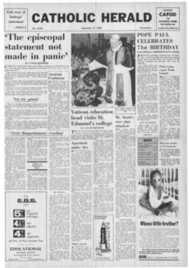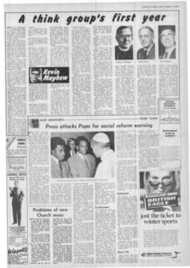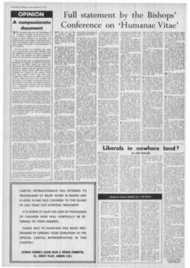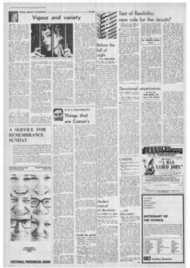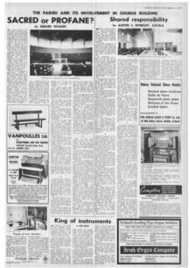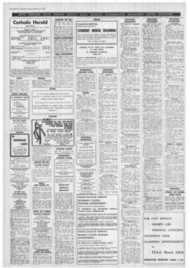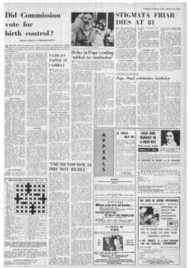Page 3, 27th September 1968
Page 3

Report an error
Noticed an error on this page?If you've noticed an error in this article please click here to report it.
Tags
Share
Related articles
Redundant Laity Body Hits Back
Commissions: Who Is At The 'nub Of The System'
Helping Laity To Play An Active Role
Vatican Plans World Laity Secretariat
How The World Saw Birth Control Ruling
a think group's first year tot Itevio alayeew . T E Laity Commission
of England and Wales is 1ardly the kind of title tha conjures up instant exc tement. Yet this body has been constantly under the Fleet Street microscope in ieccnt weeks.
irst came news that it wasi to meet to discuss the Pope's birth control encyclical, then we had the publication in The Times of a doctment the Commission ha1 prepared on the subjec . and last week we heard that the Commission had asked for discussions wit') the bishops about Hmmmae Vitae.
!most to the day of all thi sudden activity the Co mission was celebrating its first birthday as the offi ial mouthpiece of the 2.1 million Catholics of En land and Wales.
A year ago this month the Laity Commission met for the first time. It has been meeting regularly sin-e, but quietly. So far. sa)ls Kevin Muir, the CommiSsion's full-time secretat*, it has been a think grdup rather than an action group.
the Constitution of the Cornmission was accepted byithe bishops at their Low Week meeting in 1967. On September 16 the same year the founder-members todk the first tentative steps towards giving lay people a democratic voice in the affairs of the Church.
The Commission's Constitution states its purpose siMply as being to assist the apostolic work of the Church and to encourage the laity in England and Wales to play their full part in the mission of the C urch in the modern w rld.
Its establishment is provi ional for five years and one of the tasks to which the members will address themselves is to come up with ideas for the establishment of a permanent b;lmined to the principle y. "We are definitely c of democratic election."
says Muir.
The Constitution gives four /headings under the terms of reference. These are that the Commission shall: 1Examine the role, both actual and potential, of the laity of England and Wales in the mission of the Church.
2Consider methods by which all members of the Church might be brought to an awareness of and competence in carrying out their responsibilities as 'participants in the mission of the Church. and take appropriate action within the authority delegated to it by the Bishops' Conference.
2 Maintain constant toucihi
with other Commissions of the Bishops' Conference through the General Secretariat of the Conference in regard to their lay membership, and advise the General Secretariat of any matter affecting the laity not covered by other Commissions.
4 Prepare and propose to the Bishops' Conference, through the General Secretariat of the Conference. a Constitution for the Commission proper.
The Commission has
21 members plus a chairman and secretary. Bishop Worlock of Portsmouth is the President, Bishop McClean of Middlesbrough the Vice-President and Dr. Paul Black. the Chairman. Black is Reader in Physics at Birmingham University and a family man. He says of the Com
mission: ,
"The commission s task is a hard one. Imagine yourself given a blank sheet of paper and asked to say what shcrld be done about the pa t the laity play in the Church's mission. When we tried to do this. we found it difficult to know where to start and how to sort out all our different ideas— after all the commissioln does in elude people with many , different backgrounds and experiences.
"In our first year's work we have made a great deal bf progress in clarifying our policy but, of course, if this is to be of any service to the Church. we have to ask others what they think about our ideas and what should be done about them. This m ans that we shall first d scuss some issues with e Bishops'
Conference. • entrusted
us with our t. sic: we shall then present
sals for discu h;ion by the
orne propo Church as a whole.
"We can only be of service if we can succeed in encouraging and stimulating others and if we can develop our proposals by considering evidence and criticism from all parts of the Church. A few priests and lay , people have already helped us in this way and we must involve many more in the future."
According to the Constitution the National Council for the Lay Apostolate, a consultative body of Catholic societies, may fill five places on the Commission. and one place each is allotted to the National Board of Catholic Women, the Catholic Union (a nonpolitical association concerned to watch Catholic interests in legislative matters) and the National Catholic Youth Association. Other members are co-opted.
Nobody pretends that the present set-up is a crosssection -of the Catholic laity, Kevin Muir says. It is simply the most convenient way of producing the required results at this time. When the Commission was set up the only organised electorate was the network of Catholic organisations.
Although the Commission members are handpicked rather than elected, they do represent a very wide spectre of the Catholic community„ from bishops to devotees of the way-out "Slant" group.
The Commission's most distinguished member is Sir Desmond Morton, at 77 also the oldest. He is the Catholic Union represen
tative. The youngest member is Austin Winkley, an architect and the representative of the National Catholic Youth Association,
There are four priestmembers, including Fr. Michael Gaine of Christ's College, Liverpool, a sociologist, and one nun, Sr. Philomena. a family case worker.
Pat Keegan, the only layman to address the Second Vatican Council, was co-opted because of his membership of the Rome Council of the Laity and his very wide knowledge of the lay apostoiate.
A "Slant" editor is another co-opted member. He is Martin Redfern, managing director of Sheed and Ward. the publishers, and one of the leaders of the new-Left Church. He was chosen because the Commission was lacking in representation from that quarter Kevin Muir, the Secretary of the Commission, is 45 and a former leading light in the Young Christian Workers. Immediately before his appointment to the Commission he was General Secretary of Family and Social Action, a job in which he has been succeeded by Pat Keegan.
Muir. who will give continuity to the Commission by the fact that he is the only full-time officer. has worked in the lay apostolate movement in Africa, Mauritius and Madagascar.
The other members include Dr. Cicily Clarke, President of the National Board of Catholic Women. Philip Daniel. Assistant Secretary, Department of Local Affairs, and Mr. Ronald Brech, economist and one of the laymen behind the "New Pentecost."
The Commission has a budget for 1968-69 of £3,308. This includes the salary of the full-time secretary and members' expenses. Next year the budget will be raised to £5,000 in order to pay for more secretarial help.
The Laity Commission represents the largest section of the Church in this country. This week its first report goes to the Bishops of England and Wales. What kind of proTress will the members report?
According to Bishop Worlock, the first year's work has been largely concerned with finding ways of working together. "It
would have been quite wrong for the Laity Commission to charge in with all the answers to all the questions before its members had time to get to know one another," he says.
"During the past year much time has had to be spent in working out how we can most effectively carry out our tasks. To examine the layman's role, actual and potential, could mean much more than we could tackle at this stage, It could mean doing noth ing practical at all. , "In fact, we have been able to pick out some fairly vital points for inquiry and study, and only now are we beginning to come up with some interim recommendations.
"In some ways the most important thing which has happened has been that the members, bishops, priests, religious, laymen and laywomen, have been learning how to discuss, study and work together. The setbacks as well as the successes have served to bind us more closely together.
"Now with the working machinery of dialogue established, we hope that we may be of service to the bishops who established the Commission and to the rest of the community from which our members are drawn. In retrospect we shall be seen to have had a difficult but valuable first year."
blog comments powered by Disqus


